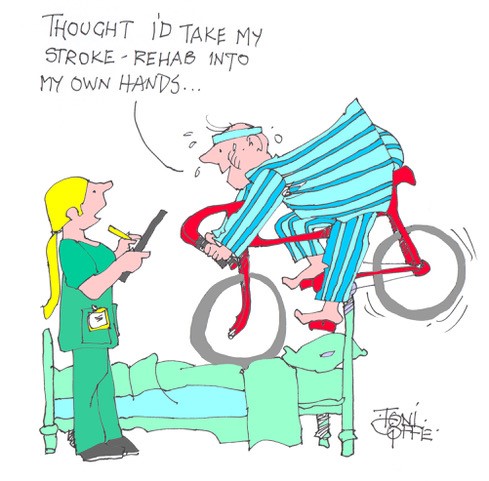EXERCISE IN THE TREATMENT OF STROKES
The use of exercise in stroke rehabilitation
Management of the acute episode
Exercise is vital to the restoration of muscle function. Rehabilitation should start as soon as blood supply to the brain has been re-established to the best possible level. It is usually provided by in-patient physiotherapy, most likely to be in a specialist stroke rehabilitation ward. Treatment is focused on strengthening the weakened muscles to improve arm and leg function and restore mobility. Balance exercises are an important part of this treatment.
There has been little research into the optimal frequency and duration of physiotherapy for post-stroke rehabilitation. What evidence there is indicates that more is better. Unfortunately stroke rehabilitation is usually under-resourced with patients seldom receiving adequate physiotherapy. Being in hospital is almost designed to reduce strength and mobility – ten days in hospital is said to be equivalent to ten years of ageing. Hospital culture encourages lying and sitting rather than being active, driven by the desire to prevent falls in understaffed wards. The sitting patient is less dangerous to him/herself than the mobile patient.
Rehabilitation has to be intense to overcome the de-training effects of being in hospital. Probably most of the gains are from the spontaneous recovery which is characteristic of strokes. The sooner the patient can be got home and returned to normal daily activities the better.
A story of how it can be done
A model of stroke rehabilitation was provided by Roald Dahl. In 1965 his wife, actress Patricia Neal, had a disabling stroke caused by a brain haemorrhage. She was left with a severe speech impediment and one sided weakness. Dahl feared she would become an “enormous pink cabbage”, so he set up – with his friends and neighbours – an intensive six-hours-a-day regime of physical activity and speech retraining. . Some professionals warned this was too much, but he ignored them. Pat was coached back to normality “slowly, insidiously and quite relentlessly”. She eventually resumed her acting career, even getting another Oscar nomination.
Long-term physical training.
This hugely important part of the long-term care of the stroke patient is seldom applied. What a pity.
A low level physical fitness is one of the risk factors for stroke. Regular exercise reduces blood pressure, improves blood lipids, gives better diabetic control and helps with weight loss. A suitable regime has been suggested as fifty minutes or so of moderate intensity exercise three or four times per week.
Other benefits of physical training
Post-stroke physical training has also been shown to reinforce the gains of early rehabilitation by further increasing cardio respiratory fitness and muscle strength and improving walking capacity. Immobility, unilateral limb weakness, poor balance, cognitive impairment, reduced activities of daily living and quality of life and the risk of stroke recurrence all benefit. Greater self confidence and independence are additional rewards.
It is hard to overstate the multiple benefits of fitness training for stroke patients. It is just as effective as standard drug treatments and maybe more effective, for reducing the risk of recurrence and subsequent stroke-related death.
PS
Bad news on encouraging exercise in the young
This week the National Audit Office has published a report on the failure of government policy to reduce obesity in the UK, particularly in young people. The report highlights the government strategies of banning unhealthy “buy one, get one free” deals, restrictions on junk-food advertising and calorie labeling on restaurant menus. Perhaps placing more emphasis on exercise could be more effective?
Apparently not!
Less than 20% of adolescents globally meet recommended levels of physical activity. A Cambridge group has carried out a trial of a school-based behaviour training (GoActive) to try to improve the situation. The students themselves had helped to construct the GoActive programme. I am disappointed to report that the programme made no difference to activity levels as measured by accelerometry (a sophisticated form of pedometry).
Oh dear – it seems that current culture discourages physical activity – could it be anything to do with the ever present mobile phone?
Subscribe to the blog
Categories
- Accelerometer
- Alzheimer's disease
- Blood pressure
- BMI
- Cancer
- Complications
- Coronary disease
- Cycling
- Dementia
- Diabetes
- Events
- Evidence
- Exercise promotion
- Frailty
- Healthspan
- Hearty News
- Hypertension
- Ill effects
- Infections
- Lifespan
- Lipids
- Lung disease
- Mental health
- Mental health
- Muscles
- Obesity
- Osteoporosis
- Oxygen uptake
- Parkinson's Disease
- Physical activity
- Physical fitness
- Pregnancy
- Running
- Sedentary behaviour
- Strength training
- Stroke
- Uncategorized
- Walking


